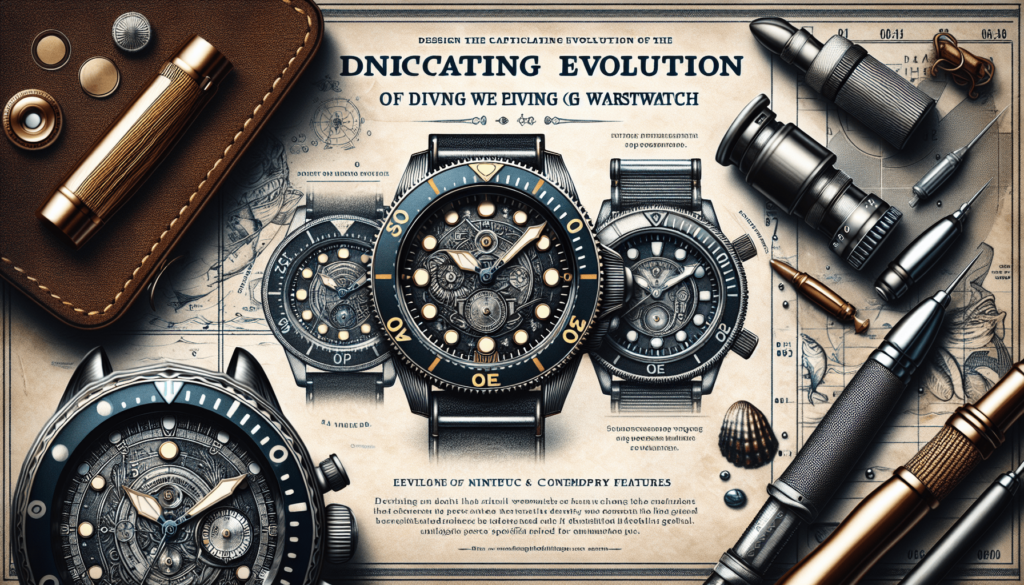Imagine diving deep into the crystal-clear depths of the ocean, surrounded by colorful coral reefs and majestic sea creatures. As you dive deeper, you glance at your wrist and see a sturdy timepiece with impeccable precision, designed specifically for the adventurous world of diving. In this article, we will embark on a fascinating journey into the history of diving watches, unravelling the tales of innovation, endurance, and craftsmanship behind these remarkable timekeeping instruments. From their humble beginnings to their evolution into high-tech marvels, we will discover the captivating story of diving watches and the invaluable role they play in the exploration of our planet’s last frontier: the depths of the sea.

Early Beginnings
The first water-resistant watches
In the early 17th century, the development of water-resistant watches began with the invention of sealed cases. These watches, often referred to as “trench watches,” were primarily used by military personnel and were designed to withstand the rigors of war. The sealing of the cases effectively protected the delicate mechanisms from water and moisture, allowing them to be used in wet and demanding environments.
The need for diving watches
As humans began to explore the depths of the ocean, the need for watches that could withstand the pressures and challenges of diving became evident. Traditional watches were not built to withstand the immense pressures found underwater, and divers needed a reliable timekeeping device that could withstand the depths.
Rolex Submariner: The pioneer
In 1953, Rolex introduced the world to the first commercially available diving watch – the Rolex Submariner. This groundbreaking timepiece revolutionized the industry and set the standard for all future diving watches. With its water resistance up to 100 meters, rotating bezel, and luminescent dial, the Submariner became an iconic symbol of reliability and functionality.
The Birth of the Submariner
Rolex Submariner: The first commercially available diving watch
The Rolex Submariner, introduced in 1953, was the first watch specifically designed for diving purposes and made available to the public. Prior to its release, diving watches were primarily reserved for military use. The Submariner’s introduction made diving accessible to a broader audience and opened up a new world of underwater exploration.
Key features of the Submariner
The Submariner was equipped with several key features that made it the perfect companion for divers. Its water resistance capabilities were improved to a depth of 200 meters, ensuring its durability in challenging underwater environments. The rotating bezel allowed divers to track their immersion time accurately, while the luminescent dial ensured visibility even in low-light conditions. These essential features set the standard for future diving watches.
Impact on the watch industry
The release of the Rolex Submariner had a profound impact on the watch industry. It not only revolutionized diving watches but also influenced the design and functionality of watches as a whole. The Submariner’s success prompted other brands to develop their own diving watch models, leading to intense competition and continued innovation within the industry.
Evolution of Diving Watch Technology
Improvements in water resistance
As diving technology advanced, so did the capabilities of diving watches. Watchmakers focused on improving the water resistance of their timepieces, allowing divers to explore greater depths. Innovative case designs, seals, and gaskets were developed to ensure that watches could withstand increased pressure without compromising their functionality.
Inclusion of helium release valves
One significant advancement in diving watch technology was the inclusion of helium release valves. These valves enabled the release of built-up helium gas that can penetrate watches during deep-sea missions. By preventing the accumulation of helium, diving watches remained functional and reliable at extreme depths.
Introduction of bezel markings
The introduction of bezel markings was another important improvement in diving watch technology. Bezel markings, often in the form of minute increments, enabled divers to accurately measure elapsed time underwater. This simple yet effective feature enhanced the safety and efficiency of diving expeditions.
Enhancements in luminosity
Luminous materials such as tritium, Super-LumiNova, and more recently, Rolex’s Chromalight, have been incorporated into diving watches to improve legibility in low-light and dark conditions. These enhancements allow divers to read the time and track their immersion time with ease, ensuring their safety and efficiency while exploring the underwater world.
Iconic Models and Brands
Omega Seamaster: A competitor to the Submariner
The Omega Seamaster, introduced in 1948, quickly became a competitor to the Rolex Submariner. With its impressive water resistance and robust construction, the Seamaster appealed to professional and recreational divers alike. Over the years, the Seamaster line has evolved, offering various models and designs that cater to different tastes and preferences.
Breitling Superocean: Emphasizing functionality
The Breitling Superocean line was specifically developed for professional and military divers, emphasizing functionality and durability. With exceptional water resistance and a sturdy build, the Superocean timepieces provided a dependable tool for underwater exploration. Its distinctive design and powerful presence have made it a favorite among diving enthusiasts.
Tag Heuer Aquaracer: A modern diving companion
Tag Heuer’s Aquaracer collection combines contemporary aesthetics with exceptional performance. Designed for both underwater and everyday wear, the Aquaracer range features advanced water resistance, precision movements, and stylish designs. It has become a popular choice for those seeking a modern diving companion.

Exploring Underwater Explorers
Jacques Cousteau: Popularizing diving and watches
No discussion of diving watches is complete without mentioning Jacques Cousteau. A pioneer in marine exploration and conservation, Cousteau played a significant role in popularizing diving as a recreational activity. His groundbreaking documentaries featured divers wearing iconic Rolex Submariners, drawing attention to the importance of reliable timekeeping devices for underwater adventurers.
Rolex and the COMEX partnership
Rolex’s partnership with COMEX, a leading company in deep-sea diving operations, further solidified its reputation in the diving watch realm. The collaboration led to the development of specialized watches that could withstand the extreme conditions encountered during underwater missions. The Rolex COMEX Submariner has become a highly sought-after piece among collectors and enthusiasts.
Tudor Submariner: A reliable alternative
The Tudor Submariner, a sister brand to Rolex, offers a reliable alternative to its prestigious counterpart. With many shared design elements and comparable quality, Tudor Submariners provide a more accessible entry point for those wanting a dependable diving watch. The Tudor Submariner has gained recognition and established itself as a respected brand in its own right.
Diving Watches in Pop Culture
James Bond and the Rolex connection
One of the most iconic collaborations between a diving watch and pop culture is the association between James Bond and Rolex. Starting with the movie “Dr. No” in 1962, James Bond sported a Rolex Submariner on his wrist, instantly cementing the Submariner’s status as the ultimate timepiece for the secret agent. The endorsement by the world’s most famous spy elevated the desirability and recognition of the Submariner.
Celebrity endorsements and diving watch enthusiasts
Beyond fictional characters, many real-life celebrities and sports personalities have become avid collectors and endorsers of diving watches. From underwater photographers to professional athletes, the choice to wear a diving watch symbolizes a sense of adventure, durability, and style. These endorsements further solidify diving watches’ place in popular culture and showcase their appeal beyond the depths.

Collecting Diving Watches
Factors to consider when collecting
When collecting diving watches, several factors should be considered. These include the brand’s reputation, the timepiece’s condition, its rarity, and the availability of original components. Collectors should also pay attention to the historical significance of a particular model and any notable features or innovations it introduced.
Vintage versus modern
Collectors often face the dilemma of choosing between vintage and modern diving watches. Vintage watches offer a unique charm and historical value, while modern timepieces often come equipped with advanced technology and cutting-edge materials. The choice ultimately depends on personal preferences and the desired characteristics of the collection.
Limited editions and special releases
Limited editions and special releases have become highly sought-after pieces among collectors. These unique timepieces often feature exclusive design elements, special materials, or collaborations with renowned individuals or organizations. Owning such a watch represents an opportunity to own a piece of history and adds a sense of exclusivity to a collection.
Investment potential
Diving watches, particularly vintage models from esteemed brands, have shown remarkable investment potential over the years. As interest in horology continues to grow, the value of rare and sought-after diving watches tends to appreciate. Collectors should conduct thorough research and consult experts to understand the investment potential of specific timepieces.
Technical Innovations
Innovations in materials and construction
Advancements in materials and construction have significantly enhanced the performance and durability of diving watches. From the introduction of stainless steel cases to the use of scratch-resistant ceramic and lightweight titanium, these innovations ensure that watches can withstand the harshest underwater conditions while maintaining their aesthetic appeal.
The rise of mechanical movements
Mechanical movements, specifically automatic movements, have become the preferred choice for many diving watch enthusiasts. These intricate movements rely on the motions of the wearer’s wrist to power the watch, eliminating the need for batteries. The precision and craftsmanship associated with mechanical movements add a level of sophistication to diving watches.
Smart features in modern diving watches
In recent years, the integration of smart features into diving watches has gained popularity. These features include depth sensors, temperature gauges, and various connectivity options. These advancements allow divers to access valuable information during their underwater explorations, making their watches not only reliable timekeeping devices but also valuable tools.

Diving Watches: Beyond the Depths
Diving watches as fashion statements
While diving watches were initially designed for underwater exploration, they have also become fashion statements in everyday life. With their robust construction, sporty aesthetics, and association with adventure, diving watches have found a place in both casual and formal wear. Their versatility allows individuals to express their personal style and showcase their appreciation for precision craftsmanship.
Using diving watches in everyday life
Despite their association with diving, these watches have proven to be functional and reliable timepieces for everyday use. The durability and water resistance that make them suitable for underwater adventures also ensure their resilience in various daily activities. From swimming to activities involving water exposure, diving watches are designed to withstand the rigors of daily life.
The Future of Diving Watches
Advancements in water resistance and durability
As technology continues to progress, we can expect further advancements in the water resistance and durability of diving watches. Watchmakers will likely develop new materials and sealing techniques to ensure watches can withstand even greater depths and harsh conditions. These innovations will enhance the reliability and longevity of diving watches.
Integration of new technologies
The future of diving watches will see the integration of new technologies to enhance their functionality. This may include the incorporation of GPS capabilities, connectivity with smartphones, and even smartwatch-like features. These advancements will provide divers with increased safety, convenience, and connectivity during their underwater expeditions.
As we explore the history of diving watches, it becomes evident that these timepieces have come a long way since their early beginnings. From being crucial tools for underwater exploration to becoming fashion statements and symbols of adventure, diving watches have captivated the hearts of watch enthusiasts and collectors alike. With continued innovations and the integration of new technologies, the future of diving watches looks promising. The allure of the depths, coupled with the precision and reliability of these timepieces, will continue to inspire and captivate diving enthusiasts for generations to come.


